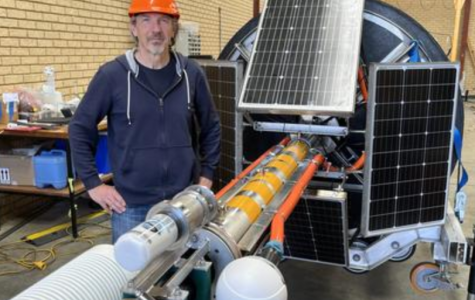Mysterious Giant Buoy off Western Australia: Is It Secretly Sending Signals to NASA?
By
Gian T
- Replies 0
In the vast and often uncharted waters off the coast of Western Australia, a towering structure has emerged, capturing the attention of seafarers and sparking curiosity among those who catch a glimpse of it. It's not a scene from a science fiction movie but rather a real-life scientific endeavour connecting the ocean's depths with the far reaches of space.
The structure in question is a 15-meter-tall buoy known as the Marine Optical Network or MarONet. It's part of a groundbreaking project that's set to unravel some of the ocean's most closely guarded secrets. This isn't your average buoy; it's an optical system equipped with advanced sensors, and it's been launched into the ocean near Rottnest Island to work in tandem with NASA's latest satellite mission, studying Earth's oceans from space.
The MarONet buoy is a marvel of modern science and engineering, designed to precisely capture the colour of the oceans. But why is the colour of the ocean so important, you might ask? Well, our members at the Seniors Discount Club know that the ocean is not just a body of water; it's a living, breathing ecosystem vital to our planet's health.
Professor David Antoine, head of Curtin University's Remote Sensing and Satellite Research Group (RSSRG), explains that while we often perceive the ocean as blue, it can appear blue-green in areas rich with phytoplankton. These single-celled plants are not only a crucial food source for marine life but are also responsible for producing over half of the world's oxygen and absorbing significant carbon dioxide, rivalling the trees and land plants on Earth.
The buoy's sensors capture and analyze sunlight reflected off the ocean to measure algae levels. This data is then transmitted to shore via the mobile network, where it's used to refine the calibration of satellite sensors for more accurate ocean monitoring. The precision of this data is paramount, as it helps scientists understand the health of our oceans and the impact of climate change on marine ecosystems.
The MarONet buoy's location near Rottnest Island was strategically chosen due to the unique oceanic conditions and clear atmosphere, which are ideal for accurate calibration. This project is a testament to the collaborative spirit of scientific research, with the buoy working in close cooperation with sea sensors off Hawaii that have been operational for over two decades.
As our members who have a keen interest in environmental conservation and science might appreciate, this initiative is a significant step forward in our understanding of the ocean. It's not just about sending signals to NASA; it's about listening to what the ocean has to tell us and using that knowledge to protect and preserve it for future generations.
So, the next time you hear about a mysterious giant buoy off the coast, remember that it's part of a larger effort to keep a watchful eye on the health of our planet's oceans. It's a reminder that even as we age, there's always something new to learn and discover about the world around us.
 We'd love to hear your thoughts on this fascinating project. Have you ever witnessed any unusual scientific equipment in your travels? Do you think these efforts will help us better understand and protect our oceans? Share your stories and opinions in the comments below!
We'd love to hear your thoughts on this fascinating project. Have you ever witnessed any unusual scientific equipment in your travels? Do you think these efforts will help us better understand and protect our oceans? Share your stories and opinions in the comments below!
The structure in question is a 15-meter-tall buoy known as the Marine Optical Network or MarONet. It's part of a groundbreaking project that's set to unravel some of the ocean's most closely guarded secrets. This isn't your average buoy; it's an optical system equipped with advanced sensors, and it's been launched into the ocean near Rottnest Island to work in tandem with NASA's latest satellite mission, studying Earth's oceans from space.
The MarONet buoy is a marvel of modern science and engineering, designed to precisely capture the colour of the oceans. But why is the colour of the ocean so important, you might ask? Well, our members at the Seniors Discount Club know that the ocean is not just a body of water; it's a living, breathing ecosystem vital to our planet's health.
Professor David Antoine, head of Curtin University's Remote Sensing and Satellite Research Group (RSSRG), explains that while we often perceive the ocean as blue, it can appear blue-green in areas rich with phytoplankton. These single-celled plants are not only a crucial food source for marine life but are also responsible for producing over half of the world's oxygen and absorbing significant carbon dioxide, rivalling the trees and land plants on Earth.
The buoy's sensors capture and analyze sunlight reflected off the ocean to measure algae levels. This data is then transmitted to shore via the mobile network, where it's used to refine the calibration of satellite sensors for more accurate ocean monitoring. The precision of this data is paramount, as it helps scientists understand the health of our oceans and the impact of climate change on marine ecosystems.
The MarONet buoy's location near Rottnest Island was strategically chosen due to the unique oceanic conditions and clear atmosphere, which are ideal for accurate calibration. This project is a testament to the collaborative spirit of scientific research, with the buoy working in close cooperation with sea sensors off Hawaii that have been operational for over two decades.
As our members who have a keen interest in environmental conservation and science might appreciate, this initiative is a significant step forward in our understanding of the ocean. It's not just about sending signals to NASA; it's about listening to what the ocean has to tell us and using that knowledge to protect and preserve it for future generations.
So, the next time you hear about a mysterious giant buoy off the coast, remember that it's part of a larger effort to keep a watchful eye on the health of our planet's oceans. It's a reminder that even as we age, there's always something new to learn and discover about the world around us.
Key Takeaways
- A giant 15-metre-tall buoy named MarONet has been launched into the ocean off Western Australia to assist with capturing ocean data from space.
- The Marine Optical Network buoy is equipped with sensors to capture the colour of the oceans and help verify observations made by NASA's PACE satellite.
- The sensors on the buoy analyse sunlight reflected from the ocean to measure levels of phytoplankton, which produce a significant amount of the world's oxygen and absorb carbon dioxide.
- The buoy's data is crucial for calibrating the satellite sensors for more accurate ocean monitoring, with the buoy's location near Rottnest Island providing ideal conditions for precise calibration.








